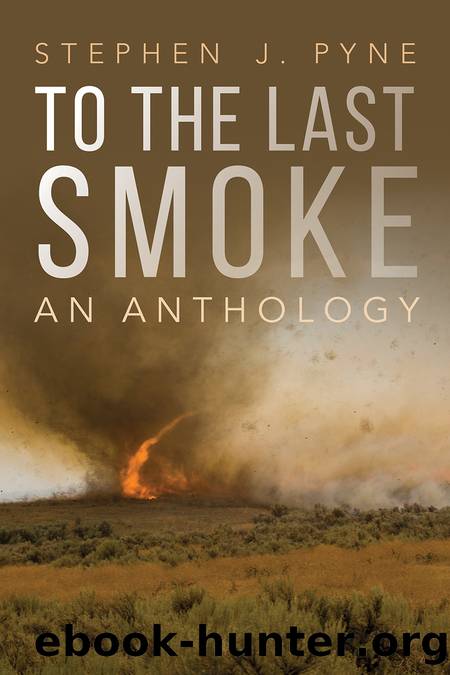To the Last Smoke by Stephen J. Pyne

Author:Stephen J. Pyne [Pyne, Stephen J.]
Language: eng
Format: epub
Tags: NAT011000 Nature / Environmental Conservation & Protection, SCI020000 Science / Life Sciences / Ecology, SCI026000 Science / Environmental Science (see Also Chemistry / Environmental)
Publisher: University of Arizona Press
Published: 2020-04-21T00:00:00+00:00
* * *
⢠⢠â¢
The San Carlos Apache Reservation sprawls, crudely gerrymandered, over 1.8 million terraced acres and many millennia of terraced time.2
Geologically, it presents a series of landscape steps crusted and filled with volcanic outflows. Each terrace replicates and lowers the one above, until the coherence of the rims and plateaus fragments into isolated peaks and valleys. The highest terrace is the Colorado Plateau in the northeast, edged by the Mogollon Rim; its lowest point, the sky islands and valleys of the Basin and Range to the southwest. The highest terraces are flat and filled with basalt. The lowest valleys are stony pediments, sinking into the floodplain of the Gila River.
Ecologically, the terracing appears as roughly contoured life zones. The Mogollon Rim boasts a robust ponderosa pine forest, grading into mixed conifer. The middle terrains are mixtures of woods and grasses; the basaltic terraces range from prairie to high-desert grasslands. The lowest landscapes are Sonoran desert, degraded into creosote. About a third is woodland; a quarter, grassland; a fifth, desert; some 13 percent, ponderosa; and the tiny remainder, human communities of some kind.
The heart of San Carlos is the Nantac Rim, a miniature of the Mogollon Rim, slashing through the middle of the reservation from northwest to southeast. Along it, ponderosa pine flourish, while the terraces that flank it are grasslandsâBig Prairie to the north and Antelope and Ash flats to the south. Near its center lies Point of Pines, where a stringer of ponderosa reaches into Big Prairie. It rests at a kind of eco-librium midpoint for rock, biota, and human history.
The human history, too, appears layered, terrace by excavated terrace. In part, this simply reflects the source of the evidence from archaeological excavations, digging down through layered culture upon culture. Instead of cascading across space, eras pile one on top of the other. But people have actively made terraces as well. Ancient agriculturalists terraced hillsides to hold soil and water, 20th-century mining terraced whole mountains to strip off ore, and archaeologists reversing the process have pulled back layer after layer by terraced pits.
Yet, a great fact of the reservation is that it runs cross-grained to that texture of time and space. Drive from San Carlos, the tribal headquarters near where the San Carlos River joins the Gila, to Point of Pines, roughly at its center, and you pass through Sonoran lowlands up through the foothill flank of the Gila Mountains to the Antelope and Ash flatlands, rich with high-desert grasslands, and then through Barlow Pass over the pine-clad Nantac Rim and onto the sweeping plains of Big Prairie. Continue from Point of Pines to Malay Gap, and you rise through a lesser plain, clothed with juniper savanna, and up to the Mogollon Rim itself. Unless you follow the Gila River, to move around the reservation is to step up and down terraces of some sort.
So it is with San Carlos history: it moves in jumps and over barriers rather than along worn pathways or the meandering floodplains of mainstream narrative.
Download
This site does not store any files on its server. We only index and link to content provided by other sites. Please contact the content providers to delete copyright contents if any and email us, we'll remove relevant links or contents immediately.
| Anatomy | Animals |
| Bacteriology | Biochemistry |
| Bioelectricity | Bioinformatics |
| Biology | Biophysics |
| Biotechnology | Botany |
| Ecology | Genetics |
| Paleontology | Plants |
| Taxonomic Classification | Zoology |
Sapiens: A Brief History of Humankind by Yuval Noah Harari(14258)
The Tidewater Tales by John Barth(12610)
Mastermind: How to Think Like Sherlock Holmes by Maria Konnikova(7235)
Do No Harm Stories of Life, Death and Brain Surgery by Henry Marsh(6891)
The Thirst by Nesbo Jo(6838)
Why We Sleep: Unlocking the Power of Sleep and Dreams by Matthew Walker(6620)
Life 3.0: Being Human in the Age of Artificial Intelligence by Tegmark Max(5480)
Sapiens by Yuval Noah Harari(5298)
The Longevity Diet by Valter Longo(5021)
The Body: A Guide for Occupants by Bill Bryson(4979)
The Rules Do Not Apply by Ariel Levy(4870)
The Immortal Life of Henrietta Lacks by Rebecca Skloot(4529)
Animal Frequency by Melissa Alvarez(4400)
Why We Sleep by Matthew Walker(4366)
The Hacking of the American Mind by Robert H. Lustig(4319)
Yoga Anatomy by Kaminoff Leslie(4310)
All Creatures Great and Small by James Herriot(4239)
Double Down (Diary of a Wimpy Kid Book 11) by Jeff Kinney(4210)
Embedded Programming with Modern C++ Cookbook by Igor Viarheichyk(4112)
